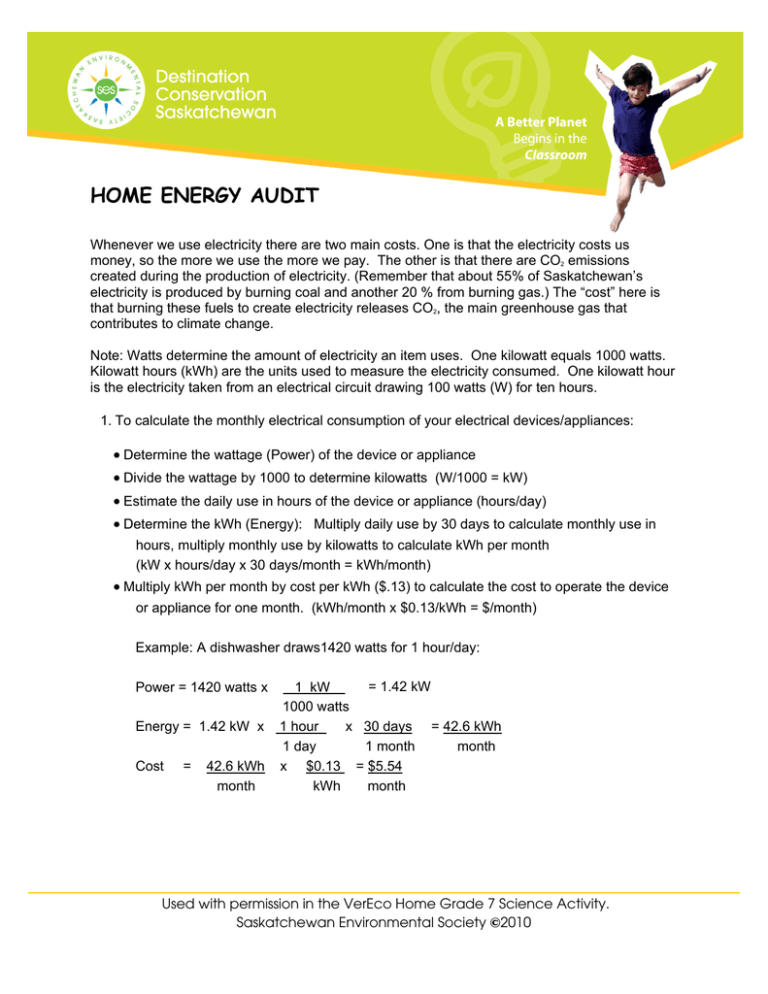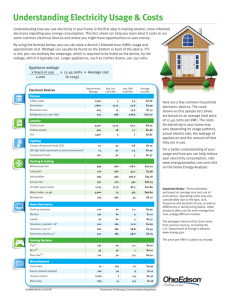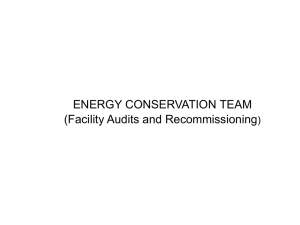Home Audits - VerEco Home
advertisement

DCS Home Energy Audit Page 1 of 4 HOME ENERGY AUDIT Whenever we use electricity there are two main costs. One is that the electricity costs us money, so the more we use the more we pay. The other is that there are CO2 emissions created during the production of electricity. (Remember that about 55% of Saskatchewan’s electricity is produced by burning coal and another 20 % from burning gas.) The “cost” here is that burning these fuels to create electricity releases CO2, the main greenhouse gas that contributes to climate change. Note: Watts determine the amount of electricity an item uses. One kilowatt equals 1000 watts. Kilowatt hours (kWh) are the units used to measure the electricity consumed. One kilowatt hour is the electricity taken from an electrical circuit drawing 100 watts (W) for ten hours. 1.To calculate the monthly electrical consumption of your electrical devices/appliances: xDetermine the wattage (Power) of the device or appliance xDivide the wattage by 1000 to determine kilowatts (W/1000 = kW) xEstimate the daily use in hours of the device or appliance (hours/day) xDetermine the kWh (Energy): Multiply daily use by 30 days to calculate monthly use in hours, multiply monthly use by kilowatts to calculate kWh per month (kW x hours/day x 30 days/month = kWh/month) xMultiply kWh per month by cost per kWh ($.13) to calculate the cost to operate the device or appliance for one month. (kWh/month x $0.13/kWh = $/month) Example: A dishwasher draws1420 watts for 1 hour/day: Power = 1420 watts x Energy = 1.42 kW x Cost = 42.6 kWh month = 1.42 kW 1 kW 1000 watts x 30 days = 42.6 kWh 1 hour 1 day 1 month month x $0.13 = $5.54 kWh month Used with permission in the VerEco Home Grade 7 Science Activity. Saskatchewan Environmental Society ©2010 DCS Home Energy Audit Page 2 of 4 Use the table below to calculate the approximate cost per month to operate electrical devices/appliances in the home. Power Appliances kW Use per Energy kWh per Cost Wattage (divide day month (kW x use per (W) by 1000) Example: Dishwasher – Standard Dishwasher – Standard – Energy star Refrigerator – Standard – Energy star TV – Standard LCD 26” – Energy star LCD 26” Hair Dryer 1420 1.42 (hours) 1 per day x 30) 1.42 x 1 x 30 = 42.6 kWh ($.10) Cost per month (kWh per month x $.10) .13 $5.54 1420 700 87 47 140 . Run 2/3 of a day =16 hrs .13 .13 .13 70 1000 0.1 .13 Computer CPU/Monitor 119 –Standard 51 –Energy star 19 Lap Top 9 –Standard –Energy star .13 Video Game System 197 tm –Playstation 3 19 – Nintendo tm Wii Information in this table was taken from Saskpower’s web site. www.saskpower.com To find more electrical devices/appliances, go to the web site and click on “cost calculator”. Used with permission in the VerEco Home Grade 7 Science Activity. Saskatchewan Environmental Society ©2010 DCS Home Energy Audit Page 3 of 4 2. Are any of your appliances/devices energy star rated? Which ones? Are they turned off or unplugged when not in use? 3. Using the Energy (KWh) from each of your appliances, calculate how much CO2 each one is producing. Use this calculation: (KWh x .83 = kgCO2.) 4. Circle the types of lighting found in your home. (You can calculate the electricity used by using the method from step 1. The wattage can be found printed on the bulb.) Note: A 13W compact fluorescent bulb puts off as much light as a 60W incandescent bulb, but uses 1/4 of the electricity. Compact Fluorescent Fluorescent Incandescent Halogen LED Used with permission in the VerEco Home Grade 7 Science Activity. Saskatchewan Environmental Society ©2010 DCS Home Energy Audit Page 4 of 4 5. What was the most common type of lighting found in your home? 6. What temperature is the furnace thermostat set to? xDuring winter months when you are home? xDuring winter months when you are sleeping? xDuring winter months when you are away? (Note: You can save 2% on your heating bill for every 1㨛 you turn down your thermostat.) 7.Does your family use timers for any electrical items or programmable thermostats in your home? 8. Are the furnace and hot water tank high efficiency? Are hot water pipes wrapped in insulation? 9. Can you feel drafts around doors and windows? Which ones? 10. What could your family do to be more energy efficient? Used with permission in the VerEco Home Grade 7 Science Activity. Saskatchewan Environmental Society ©2010 DCS Home Energy Audit Page 5 of 4 HOME WATER AUDIT When we turn on a tap in our homes, the water that comes out of it has come a long way from its source. It has been pumped from a river, lake or well, and then it has been filtered, treated and pumped to our homes. When it leaves our homes it is pumped, filtered and treated again before being released to a water body. That whole process uses a lot of water and a lot of resources like electricity. As well, climate change is expected to reduce the amount of fresh water available in Saskatchewan, at the same time as agriculture and industry are requiring more. Access to water is likely to become more of an issue in coming years. 1. Does your home have low flush or dual flush toilets? (3-6 litres) If not, check how much water your toilet uses per flush. Look for numbers printed on the toilet like “13 lpf” (litres per flush). xEstimate how many times toilets are flushed in your house each day and multiply that by the lpf. How much water is your family using to flush toilets every day? Eg: 10 flushes x 13 liters/flush = 130 liters 2. Do older toilets have water saving features like tank water level regulators? E.g. a brick or jug that displaces water? 3. Are the toilets checked regularly for leaks? 4. Does your home have low-flow shower heads? (9.2 l/min or less) xEstimate how many showers your family takes each day and how many minutes they shower for. xCalculate how much water is used by each person and by all showers. Note: Older showerheads use approximately 16 l/min Eg. Shower#1: 5 mins. 5 mins x 9.2 litres/minute = 46 litres of water Shower #2: 10 mins. 10 mins x 9.2 litres/minute = 92 litres of water Total water used: 46 litres+ 92 litres= 138 litres of water. Used with permission in the VerEco Home Grade 7 Science Activity. Saskatchewan Environmental Society ©2010 DCS Home Water Audit Page 2 of 2 5.Are there aerators on taps in bathrooms and kitchen? (Aerators increase the pressure of the water while decreasing the flow.) 6. Do family members turn off the water while brushing their teeth? xBrush your teeth with the water running. Plug the sink or collect the water in a large bowl. Measure the water you collected. (Try this without using toothpaste – it will be less messy!) xNow brush your teeth again, only turning on the water to fill a cup or rinse your toothbrush. How much water did you collect this way? 7. Is laundry done only with full loads? Is laundry washed in cold water? Is laundry hung to dry? (These last two won’t save water, but will save energy.) 8. Is the dishwasher only used with full loads? 9. What could your family do to further reduce their water consumption? Used with permission in the VerEco Home Grade 7 Science Activity. Saskatchewan Environmental Society ©2010 DCS Home Water Audit Page 3 of 2 HOME WASTE AUDIT Many of the items that we buy become waste very quickly. For example, a pen often comes in a plastic and cardboard package that we remove and discard right away. After the pen has run out of ink, we discard the plastic pen and its parts. Many food items come wrapped in plastics or placed on foam packaging. These items and sometimes the leftover foods are discarded when no longer needed. Consider what you buy and if there are options that have less packaging or none at all. 1. How does your family reduce waste? (E.g. buying in bulk, using durable items, buying food from farmer’s markets, etc.) 2. Does your family reuse items? Which ones? (E.g. cloth rags instead of paper towel, not using disposable dishes, etc.) 3. What items does your family recycle? 4. Does your family compost food and yard wastes? Used with permission in the VerEco Home Grade 7 Science Activity. Saskatchewan Environmental Society ©2010 DCS Home Waste Audit Page 2 of 2 5. Weigh all your garbage bags for one week. xHow much garbage does your family create? xDid you notice any items in the trash that could be recycled or reused? xWere there items that could have been reduced? E.g. individually packaged snacks could be replaced by a large package of snacks or a homemade snack. 6. What could your family do to further reduce the amount of waste put in the garbage? Used with permission in the VerEco Home Grade 7 Science Activity. Saskatchewan Environmental Society ©2010





